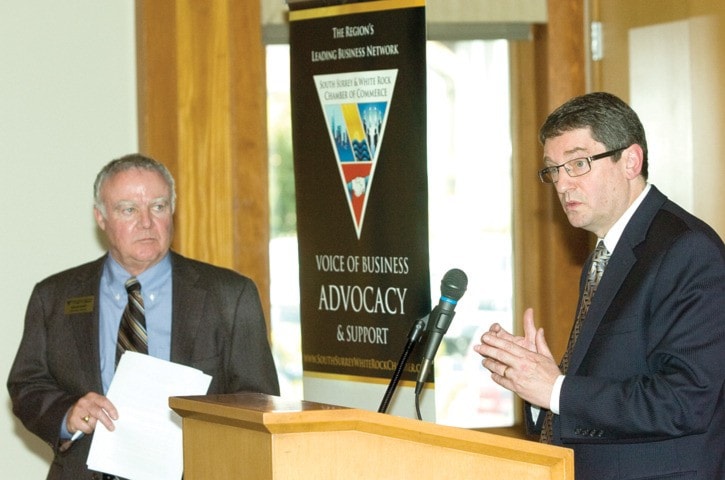Bus service from South Surrey to Langley is one of TransLink’s top priorities.
That’s according to TransLink CEO Ian Jarvis, who spoke to a business crowd during a South Surrey and White Rock Chamber of Commerce luncheon this week.
Jarvis, an Ocean Park resident, said a bus route was already laid out for White Rock Centre to Langley but was cancelled before its scheduled launch in December 2009 due to funding shortfalls.
The 531 bus was scheduled to run every half hour along 24 Avenue, bringing transit service to Grandview Corners, Morgan Crossing and Campbell Heights Industrial Park – areas that are in need of additional service, Jarvis said.
In terms of bus networks, the connection is TransLink’s “next priority.”
At Tuesday’s business lunch – held at Morgan Creek Golf and Country Club – Jarvis also addressed the end of the 351 as a single-seat bus ride from White Rock to Vancouver after the opening of the Canada Line.
The change “was not without controversy,” he noted, referring to protests and petitions to keep the direct route.
However, Jarvis said, redirecting the route to Bridgeport in Richmond has allowed improved frequency and expanded hours of service to Surrey buses, including the 351.
He said the change has provided a more viable bus trip, “one I think is truly competitive with the car trip from White Rock to Downtown (Vancouver).”
Jarvis also pointed to the City of Surrey’s plans to revitalize Whalley, and said TransLink needs to support those efforts with transit service.
When asked by an audience member to comment on the tolling of bridges, Jarvis said that he personally thought system tolling to be most effective, as a GPS in vehicles would track when, where and how much drivers use roads.
However, “the technology is there, but not quite there,” Jarvis said, noting the mayor’s council on regional transportation is the best place for such conversations. “The discussion between the mayors of the province is the right way to go.”
In response to another question, Jarvis said TransLink is looking into making additional – and more detailed and accurate – information on road traffic conditions available to commuters, so people can pre-plan trips and avoid congestion.
The ability to provide sufficient service to a growing population depends largely on the allocation of additional funding, TransLink board chair Nancy Olewiler pointed out.
Olewiler, who also spoke at the luncheon, said the mayor’s council is currently working on finding long-term, sustainable funding options.
